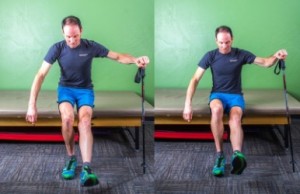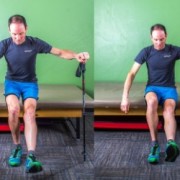A September 27, 2016 Outside.com article by David Roche (Nike Trail Elite team member) reminded me of the vast amount of misleading information found online regarding strength training for runners. While the article did list both pros as well as cons of strength training, the take home message of the article was “if you want to become a better runner, then just run, and run a lot.” Not only will this advice increase one’s injury risk, but it only truly applies to approximately 1% of the running population. 
The other 99% of us balance family, full-time jobs, injury history, and less than perfect running biomechanics. For us, simply running, and running a lot increases our injury risk. An individualized, targeted running-specific strength training program is an excellent way to improve performance while reducing injury risk. Fortunately, the research supports the importance of strength training for endurance runners and now is the time of year to focus on strengthening in preparation for a successful, enjoyable, injury-free 2017 running season.
A 2010 research article in the Journal of Orthopedic Sports Physical Therapy showed a correlation between impaired muscular control of the hip, pelvis, and trunk and increased knee pain in runners.iA strength training program aimed at providing functional stabilization of the hip and pelvis in multiple planes is, therefore, a vital part of a knee rehabilitation program. A 2009 Journal of Orthopedic Sports Physical Therapy study analyzed the hip stabilization mechanics of twenty-one female runners with patella femoral knee pain compared to the twenty pain-free female runners.iiThe study confirmed increased hip/gluteal muscle weakness with associated femoral internal rotation (knee collapses inward) in the group of women experiencing knee pain. Finally, a 2015 research article in the International Journal of Sports Medicine looked at factors which contribute to the high incidence (19.4% to 92.4% of runners will experience a running injury) of running injuries.iiiThe study concluded that in addition to training errors, changes in the joint mechanics due to poor muscular strength increase injury risk in runners. Running form can be modified in subtle yet crucial ways to reduce joint impact force through resisted double and single leg gluteal, hip, core, and lower leg/foot strengthening.
Now that we agree that strengthening is important for runners, what is the best way to strength train? Should I do body weight resistance exercises only, or should I lift weights? If I lift weights will my muscles bulk up and slow me down when I run? While body weight resistance exercises are a great way to isolate single leg stabilization, weight resistance exercises (dumbbells, kettlebells, weighted bars) are necessary to build power and durability for endurance runners. Exercising on machines while seated will not build strength specific to running as balance and weight bearing are absent. If you are presently injured or have an injury history, consult a physical therapist training specifically to work with runners. The number one predictor of a future running injury is a prior running injury history. It is important, therefore, to have a physical therapist analyze your running biomechanics. At Sapphire Physical Therapy, our on-site 2D video running gait analysis system allows us to detect compensations which impact performance and perpetuate your running injury risk.
Fall and winter are the seasons to address compensations and weaknesses through an individualized strength training program. Sapphire Physical Therapy is here for the 99% of runners for whom this article applies.
The following are links to three Sapphire Physical Therapy videos. Each video emphasizes proper exercise technique, the target musculature of each exercise, and proper demonstration. Copy and paste each link to learn how to begin incorporating running-specific strengthening exercises into your training program: iv
*Beginning Strengthening for Runners video:
https://youtu.be/5_0ADao2N1s
*Advanced Strengthening for Runners video:
https://youtu.be/WEflKMSIv0s
*Dynamic Warm-up for Runners video:
https://youtu.be/flw5l7rCaVI
John Fiore, PT
Sapphire Physical Therapy
john@sapphirept.com
References:
1 Powers C. J Orthop Sports Phys Ther 2010;40(2):42-51. doi:10.2519/jospt.2010.3337
1 Souza R, Powers C. J Orthop Sports Phys Ther 2009;39(1):12-19. doi:10.2519/ jospt.2009.2885
1 dos Santos AF et al. The E ects of Forefoot … Int J Sports Med 2015; 36: 1–5 i Powers C. J Orthop Sports Phys Ther 2010;40(2):42-51. doi:10.2519/jospt.2010.3337 ii Souza R, Powers C. J Orthop Sports Phys Ther 2009;39(1):12-19. doi:10.2519/ jospt.2009.2885 iii dos Santos AF et al. The E ects of Forefoot … Int J Sports Med 2015; 36: 1–5





